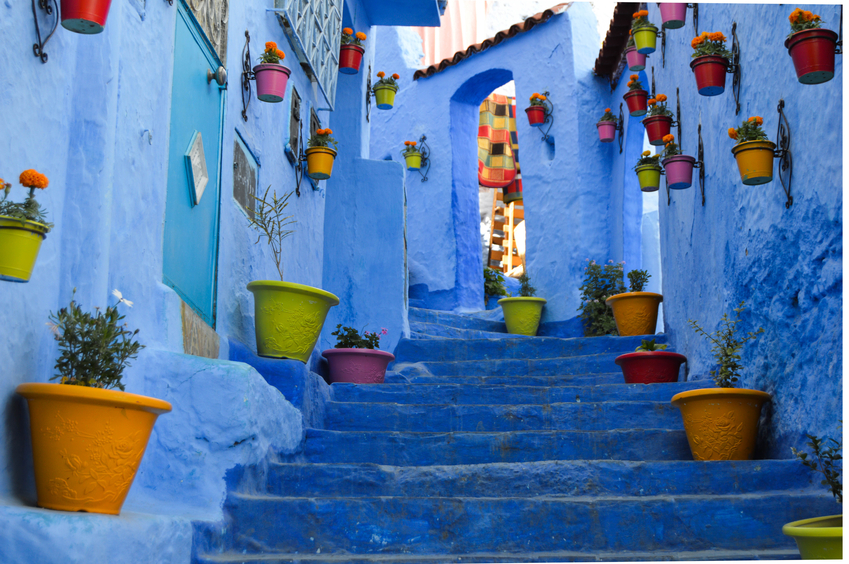
Travelers to Morocco are filled with expectations formed from the many movies, novels and news based in the region. The Kingdom’s extensive heritage and culture, its food, architecture, landscapes and people, all of which combine to make it a must-visit destination for today’s travelers.
Upon arriving into the capital city of Casablanca, one realizes the small town depicted in the American movie has turned into a westernized cosmopolitan city. In the financial and commercial center, you’ll find international clothing brands, luxury hotels, and trendy restaurants and bars. The main cultural attraction is the Hassan II Mosque. Morocco’s largest mosque features gigantic titanium doors, huge chandeliers, and marble columns decorated with green and blue tiles which combine perfectly with the shades of the sea. If Casablanca is one of your favorite films, you can’t leave the city without visiting the famous Café Rick. Although not the original, it was designed to recreate the bar famous from the Academy Award winning movie.
As you venture south, visit Ksar of Aït Ben Haddou, a Berber fortress. The UNESCO (United Nations Educational, Scientific and Cultural Organization) World Heritage Center is visually stunning and surrounded by huge walls. Its scale and splendor bring back memories of the many movies filmed there such as Gladiator, Alexander, and Babel. The fortress is near to the dazzling gorges of Dades and the deep ravine made by the river Dades, which is on the way to Marrakesh.
Another popular destination is Jamaa el Fna Square — the heart of the city of Marrakesh, especially at night. It is full of life, with vendors and visitors everywhere. Wandering around the streets, one discovers henna ladies — experts in hand painting. Henna art, originally developed to cool the skin and adorn brides, includes intricate designs with meanings such as joy and love. It is certainly the perfect souvenir that won’t take up extra room in your luggage. If you have a big suitcase, the market offers thousands of items including Moroccan lamps, carpets, spices, shoes, and the famous Fatima’s hand key chains. Be prepared to bargain, otherwise, you have not fully experienced Morocco.
In the heart of the Sahara, experience Merzouga, a spectacular oasis to relax and meditate. Merzouga is full of breathtaking landscapes, with sand orange shades and multicolor sunsets. An incredible experience is the slow ride through the dunes on a camel. After a day riding across the desert, take in the evening tranquility at the jaimas (Moroccan tent) in a magnificent tourist camp with suitable bathrooms and showers. Under a sky full of stars, guests enjoy a hearty dinner of local fare, accompanied with regional music and the rich tapestry of stories about the Berber people. Be sure to wake up in time to enjoy the striking sunrise and then head to the small village of Khamlia to enjoy Gnawa drummers in traditional costumes of white and red.
A must see is the city of Fez, which hosts the largest and oldest royal palace of the country. Although not open to the public, you can see the famous seven golden gates and admire the detailed reliefs and drawings framed with brightly colored tiles. The best of Fez is the Bab Bou Jeloud entrance, a UNESCO World Heritage medina (old downtown). Fez´s medina, the largest in the world, is actually a maze. It is easy to get lost, so hiring a tourist guide would be helpful. The city’s uniqueness lies in the authenticity of the traditional shops, tanneries, mosques, and bakeries — a mixture of colors and smells along the narrow streets with carts and donkeys transporting wares. It is impossible to leave Fez without buying a typical Arabic turban (keffiyeh), which includes instructions on the different ways to wear it.
Another “must see” stop is the town of Chefchauen, known as “the blue village” for the bright color of its medina houses. Walk the streets of alleys and arches, decorated courtyards and weavers’ and woodworkers’ shops. Before leaving the great country of Morocco, visit Uta el-Hamman Plaza to enjoy one last meal: a tajine of vegetables on a bed of cous cous accompanied with the typical thé a la menthe.
Travel Details
The center of Casablanca is about 20 miles from the airport and is accessible by a 30-minute train ride or the CTM bus which takes an hour to get to downtown.
In order to grow tourism, King Mohammed VI has made traveling around Morocco easier with added investments to the transportation infrastructure.
There are many languages spoken in Morocco and English is used in major tourist areas.
There are many options for travel between cities. Public transport options including rail and bus are quick, affordable and convenient. If you prefer private transport, cars and taxis are available for hire. Quick flights throughout Morocco are available.
Travel Time
- Casablanca to Marrakesh: 2.5 – 3 hours driving
- Casablanca to Chefchaouen: 2.5 hours flying
- Casablanca to Ouarzazate: 3 hours flying
- Casablanca to Fez: 4 hours by train
Getting There
Non-stop service to Morocco from Dulles International from Royal Air Maroc